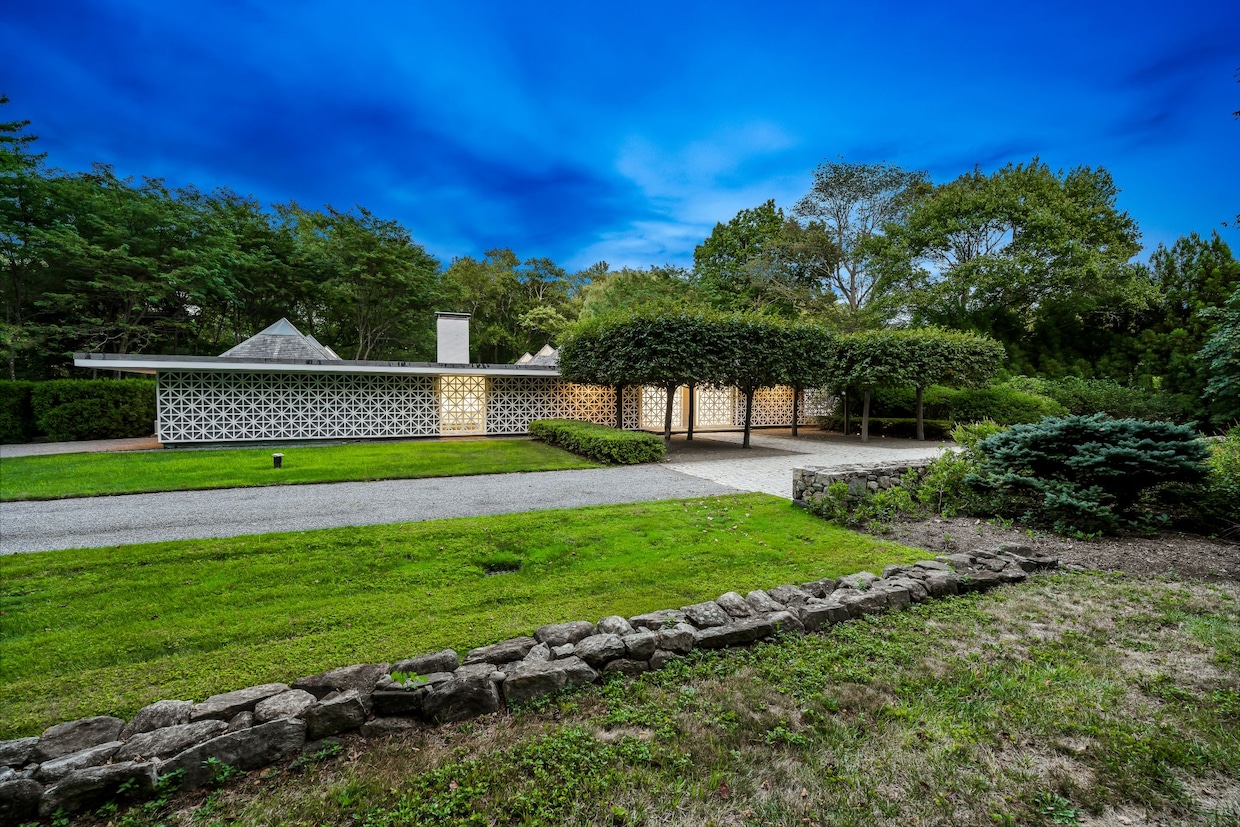With its ornate exterior and rooftop array of glass-tipped pyramids, the "Celanese House" was always intended to look cutting-edge. But it was never designed to be a residence.
Nestled into a rolling plot in New Canaan, Connecticut, the 4,927-square-foot structure began its life as a marketing tool of sorts: Celanese Corp., a materials developer, tasked architect Edward Durell Stone with designing a structure that looked like a home and acted like a home, but was actually a place where the Irving, Texas-based company could showcase its latest innovations in residential building materials.
Even then, Stone was a heavy hitter in the design world. Born in 1902, the American architect became a principal designer for the Rockefeller Center’s Center Theatre and Radio City Music Hall around 1930. In 1933, he launched his own practice, garnering accolades for his boundary-pushing residential designs (such as the "Mandel House") and contributing work to the Museum of Modern Art’s 1936 addition in New York City. In 1959, Stone started working on the John F. Kennedy Center for the Performing Arts in Washington, D.C., a project that became his “most prestigious commission” and “one of his most critically scorned works,” according to a biography of the architect.
Stone designed the Celanese House just before he began his Kennedy Center commissions, but the residence’s original building costs fell on local contractor Theodore de Freyne Hobbs, who purchased the property in 1957. The Celanese Corp. served as the home’s corporate sponsor, providing Hobbs with free or heavily discounted materials in exchange for publicity rights and press coverage.
The company was introducing new residential fabrics, materials like linoleum flooring and curtains, but “it was never designed to be a residence,” Sotheby’s broker Inger Stringfellow said. “It was designed to be a showcase house.”


Still, through architectural twists of fate, the showcase at 565 Oenoke Ridge did become a home, and Stringfellow has the listing for $4.4 million.
Duo of renovations modernized the midcentury modern residence
After its early showcase years, the Celanese House went residential around 1960.
A local couple, Frederick and Velma Willcox, bought the home, where they lived until the early aughts. By then, Stringfellow explained, “it was in pretty dire shape.”
An investor purchased the home and tried to restore the structure to its original form, repairing its lacy exterior trellis and shoring up the 12 skylight pyramids dotting the home’s flat roof. Some of that innovative linoleum material didn’t stand the test of time, Stringfellow noted, so the interior also got refreshed before the investor put the flipped home back on the market around 2005.



Today’s sellers purchased the home for roughly $4.1 million at the time, undertaking another major renovation to align the property with their personal tastes and expansive collection of art and books.
Some of those updates included luxurious finishes, such as white oak floors and floating drywall detailing. Still, Stringfellow said, the work reflected Stone’s vision down to its details — an impractical pond at the entry became an underlit glass rectangle, evoking the water feature it replaced, and landscaping ensured that the linden trees showcased the rooftop pyramids.
For Stringfellow, the home has a magical quality of light. Spilling through ceiling-height windows and the triangular skylights — inverted pyramids on the inside — the light “dances off all of the walls.”
Style could lure a small but passionate buyer pool
Although this listing came to Stringfellow recently, the Celanese House has been on and off the market for a while: In 2024, William Raveis Real Estate had it listed for $4.7 million.
At this price point, Stringfellow explained, it’s the kind of niche listing that attracts specialized buyers. Like many midcentury modern homes, the residence has only four bedrooms, and they are small and “very basic.” It also doesn’t have a pool or a tennis court, which buyers at this price point might want, Stringfellow noted.


And, as with all midcentury modern homes, some buyers might simply not like the style, with its orderly, pared-back lines and emphasis on an indoor-outdoor lifestyle.
Still, New Canaan is a good market for such a home, Stringfellow noted. Thanks to its proximity to Harvard’s design school, the New England region has a dense concentration of midcentury modern homes.
So, it might be a “small segment of the market,” Stringfellow said, but “the people who want these homes are usually more passionate about them.”

